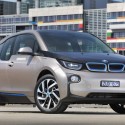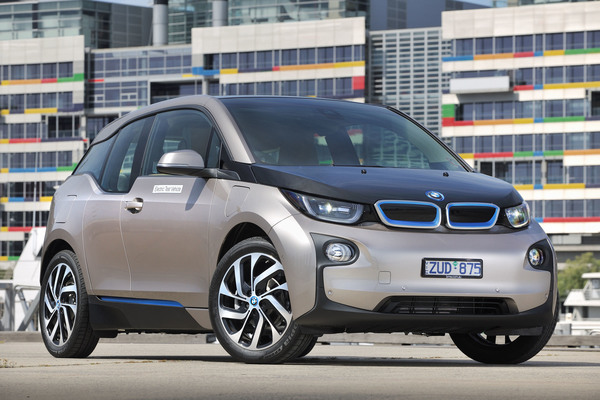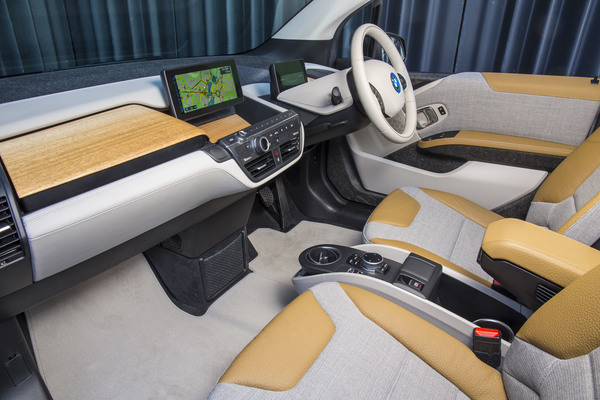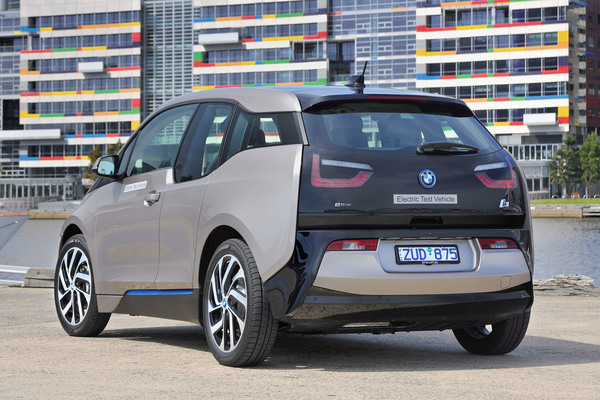By PETER ANDERSON
THE problem with most electric cars is that carmakers aren’t willing to do something a bit different. Most zappers are based on existing platforms with a few blue lights and modified panels and just aren’t very interesting. Thankfully, Tesla and Nissan are exceptions to that rule.
The BMW i3 is almost completely unrelated to anything else to come out of the Bavarian brains trust and takes zero emissions to the masses with a completely fresh outlook.
BMW i3 comes in two flavours – fully electric BEV (Battery Electric Vehicle) or engine-assisted REX (Range EXtender). It’s a simple pricing structure – $63,900 for the BEV and $69,990 for the REX.
Our BEV came with 19-inch alloy wheels, keyless entry and start, four-speaker stereo with DAB and USB, DVD player, climate control, rear view camera, cruise control, sat-nav, auto headlights and wipers, front and rear parking sensors, partial leather trim and voice recognition.
Optional extras include a Harmon Kardon stereo, LED low-beam headlights (standards are halogen, so $1077 well-spent), glass sunroof ($2246) and heated seats ($562). Our test car had those last two, taking the total to $66,708.
Stubby. Short. Chunky. Tall. All of these adjectives were thrown at the BMW i3 and they all work. It’s a weird looking car from a lot of angles, with a stepped window line, whacky, half-size rear suicide doors, snub nose and tall 19-inch alloys. It’s not self-conscious like Toyota’s Prius, sleek like the Tesla or arresting like BMW’s own i8.
It was no surprise the i3 garnered an enormous amount of attention at standstill and on the move.
Taking punters around the car elicited plenty of whistling and head-shaking, the good kind. Most remarked on the small boot but all accepted there was plenty of room for a normal shopping trip and putting the seats down put this beyond doubt.
The interior is a tactile wonderland – woollen seat covering, BMW’s shredded-tyres-and-bits-of-stuff door cards (Premium Next, they call it), the wave of sustainable eucalyptus wood on the dash and two big screens all give the car an other-worldly air, far more so than the curiously restrained interior of the i8.
Its clever shape is all about a big box inside, belying its apparently compact exterior dimensions, with tons of headroom for all passengers, even if rear leg and footroom aren’t too flash.
There’s a lot going that’s brand new both inside and out of the BMW that left most people close to speechless. Pretty impressive from a mainstream maker not often keen on taking big risks.
The i3 carries six airbags, ABS, traction and stability controls for a five star ANCAP rating.
Additionally, and outside of the ANCAP scope, the i3 has a pedestrian warning sound (no, not the horn) – you really can creep up on someone.
The 10.25-inch screen dominates the centre of the dash and is run by BMW’s iDrive system from a console-mounted rotary controller. As ever, it’s extremely usable and that big screen can be seen by everyone in the cabin.
The four-speaker stereo is perfectly adequate but the lack of AM radio in tunnel-infested Sydney isn’t – the DAB is fine when it works but only the Harbour Tunnel looks after you when it comes to digital reception.
The i3’s rear wheels are driven by a 125kW/250Nm electric motor with a claimed 130km range from a full charge. If you want to travel 130km, you’ll do it without air-con, heating or anything much in the way of comforts. You can do it though, unlike the often-laughable fuel figures most cars wear on their windscreens.
A distance of 130 km is plenty for most daily commutes but doesn’t allow for any errors in judgement or forgetting to plug it in.
It will take all night to charge on a standard domestic power supply but you can buy a wallbox to shrink that down to a few hours. A full charge will only cost a few bucks.
Let’s get down to it – this is probably the best city car ever made. It’s perfect for squirting around town and never leaving. Quiet, quick and composed you can zap (sorry) around the city at an almost indecent clip, the accelerator instantly answering the call of your ankle’s flex.
BMW i3 feels light and chuckable, the only black mark being the brutal traction control cutting in to stop spin and power wastage. It recovers quickly, but it feels a bit basic.
Once you get over the idea, you can’t feel and hear the car running, the i3 is a delight. Most of the time you’ll not go near the brake pedal, the aggressive energy recovery program (especially in ECO-PRO mode) applying plenty of drag to recover as much energy as possible and can bring the car to a standstill.
The gear selector is a bit awkward, however – perched where you might expect a wiper or indicator stalk, it feels counter-intuitive as you rock it backwards and forwards to select R or D. Obviously, with time, it will be fine, but it took us the whole week to get right.
Sadly, for Australian owners, you’ll always have one eye on the range. The utter incompetence of governments at all levels means there’s zero obligation on infrastructure owners – like shopping centres – to provide facilities for charging your car. If you’re not in the major CBD or a small group of suburbs, you’re pretty much stuffed as there’s nowhere to charge. You can try bowling up to a BMW dealer, but that will soon get tiring.
Travel to a proper city like London or Berlin, you can’t move for blue-LED lit beacons of reasonably-priced (or free) juice for your electric car. Willoughby Council on Sydney’s North Shore has a pair of parking spots (under a building site) with standard power sockets and Chatswood Westfield has a far-flung pair of spots with a fast-charger, but that’s about it.
The charging situation is as pitiful as the car is brilliant. While not yet at a super-accessible price – upwards of $63,000 even for a premium hatchback is stretching it – it’s a proper piece of the future right there in your driveway, bursting with serious technology and space-age materials.
BMW got everything right, except perhaps the range which could do with doubling. But the rest is terrific – everything about it is forward-thinking and beautifully engineered with its intelligent use of materials gives us a preview of the future of the entire automotive industry.
LIKES: Adventurous interior, great handling, sprightly acceleration
DISLIKES: Government ignorance, slow charging at home without wallbox, city-only proposition.










